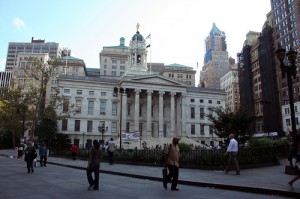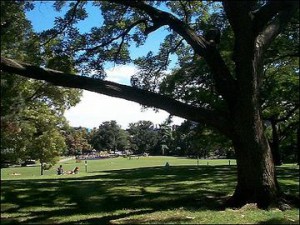While many historical buildings have been demolished during the growth of New York city there are a few that withstood the test of time and now stand as a reminder of how much value our history means to us. When the Brooklyn historical society was first erected, it was designed by an expert in his field and has continued to evolve beyond his expectations into a modern sustainable building open for all generations to visit and enjoy. Before its renovation in 1999 it stood for over 100 years. Proving the quality of work that went into it has payed off. When renovation started in 1999 changes had to be made to accommodate the changing times while maintaining the historical vibe to the building. Modern technology was integrated into the building to comfort the visitors efficiently. Just like the people with the thirst for knowledge who visit the library the building itself is expanding its reach into the possibilities of modern technology to reach out to the younger generations who wish to experience a piece of history.
The Brooklyn historical society is a library, which connects us to the 400-year-old history of Brooklyn. It was founded as Long Island Historical Society by Henry Pierrepont in 1863. It is Located in the heart of Brooklyn in the neighborhood of Brooklyn Heights at the intersection of Pierrepoint Street and Clinton Street. It was listed on National Register of Historic Places Listings in Kings County, New York as National Historic Landmark in July 1991. Also the presence of Brooklyn Historic Society in the list of museums and cultural institutions in New York City makes it internationally known Historical and Cultural Monument. At its exhibitions, Brooklyn Historic Society hosts 9000 members of the general public and serves around 120,000 students and teachers by providing the educational tours every year.
George B. Post designed and constructed the Brooklyn Historical Society. The construction was completed in 1881. George B. Post, known for engineering skills like designing open-large spaces and construction of high storyed buildings. The first office building to use elevators “Equitable Life Assurance Society”, was designed by him. He’s also known for enormous sky-lighted hall of New York Produce Exchange. Also the buildings – World building and St. Paul were one of the tallest buildings in New York at the time of construction. Most of his designed buildings have been demolished. NYSE designed by him continues to be one of the intuitive ways to use steel support.
The design, construction and maintenance are three aspects of architecture, which makes the building a National Historic Landmark. George B. Post completed Brooklyn historical society in 3 years. Post used terra cotta ornamentation on the façade in large scale in Brooklyn historical society building. An innovative truss-system was used to give the support to the ceiling of the central library. For the first time locally produced terra cotta was used in buildings masonry construction. Olin Levi Warner sculpted the façade. He used the heroic characters of history. Post hired skilled crafts person to enhance the interior of the building. Library is decorated with carved black ash woodwork. Well-known artist Charles booth is believed to be the originator of stained glasses used in the windows of the building. Post himself designed the bronze hardware used in the building. Minton tiles are used throughout the building. An open galleried library was created by suspending the top floor of the building from iron trusses embedded in the roof. A special bridge technique was used to create the part of library.
A complete renovation of the Brooklyn Historical Society took over in 1999-2003 by Jan Hird Pokorny Associates. A climate control system was installed to preserve the historic collections. Restoration of the terra cotta facade and the roof was done. The original bright red outlook of the facade was retained through cleaning & repair. High speed Internet was installed to enhance the usability of the library. Grandeur of the entrance was restored by the removal of the elevator, present in the middle of entrance staircase. Also the clock tower was renovated. The original gas lighting fixtures from 19th century retains its original decorative aesthetics. The restored Othmer Library maintains the historic essence of its old classic interiors with the introduction of new climate-control system for the preservation of its historical collections.
In 2012, announcement for renovation of the Brooklyn Historical Society was made and Brooklyn Borough President Marty Markowitz, New York City Department of Cultural Affairs, Brooklyn Delegation of the New York City Council and the New York City Office of the Mayor made the funds available. The architecture firm Christoff:Finio was given the renovation project to improve the visitor experience through redesigning the lower level & first floor of the library building. The first floor will have new Reception Desk. Redesigning of the lower level will result in expanded exhibition place.
The monumental main entrance has been redesigned to a tiled lobby with classrooms, information desk for the visitors, commercial retail spaces, and event halls. The event hall will be expanded to include 200 seating arrangements, controllable/programmable new lighting system, new chairs, tables, mobile stage & built-in Audio Video equipment’s. The space could be rented for programs & events. This project will take the Brooklyn Historic Society to a new platform.
Although there were three different individual involved during the renovation process over the couple of past years but they all had a very different kind of mind set and mentality about constructing or making changes to the magnificent place. For example: The Construction done by George B. Post emphasized more about the exterior architecture where as when the renovation in 1997 started the contractor also considered working in the interior part of the building. In conclusion, even though all of them had an distinct point of view on the building but all the changes done were to add more value to this prestigious location.
References:
Brooklyn Daily Eagle(2013, Oct 17).Grande Dame of historical buildings now more seductive to public visits. http://www.brooklyneagle.com/articles/grande-dame-historical-buildings-now-more-seductive-public-visits-2013-10-17-123000
Jennifer Medina (2005, Aug 2005) http://www.nytimes.com/2005/08/16/nyregion/16brooklyn.html?pagewanted=all&_r=0
Brooklyn History under the category About Us http://brooklynhistory.org/

![IMG_0687[1]](https://openlab.citytech.cuny.edu/beinginbrooklynf2013/files/2013/10/IMG_06871-300x224.jpg)




